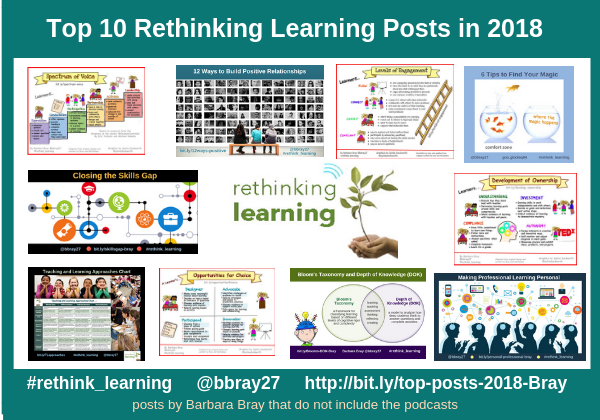2018 went by so fast. It has been a very interesting year in education along with every aspect of our world. Because of the changes, I needed to update some of my posts, graphics, and resources. I have been fortunate to participate in amazing discussions at conferences, summits, and with awesome educators in my podcasts. I have learned so much from inspirational educators and realize that there is always something new to learn and share. Beyond the posts that go with each of the podcasts, I wanted to share the top 10 posts with you that others shared on social media. These are in no particular order. I just wanted you to have access to them from one page.
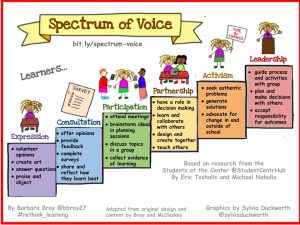 There are so many aspects of “school” and “learning” where students have not been given the opportunity to be active participants. Giving students voice encourages them to participate in and eventually to own and drive their learning. This means a complete shift from the traditional approach of teaching compliance that develops a “learned helplessness” to encouraging voice where there is authenticity in the learning.
There are so many aspects of “school” and “learning” where students have not been given the opportunity to be active participants. Giving students voice encourages them to participate in and eventually to own and drive their learning. This means a complete shift from the traditional approach of teaching compliance that develops a “learned helplessness” to encouraging voice where there is authenticity in the learning.
Are our schools and universities preparing our children for the new skills they will need to be successful? How we taught and still teach our children in our K-12 and university systems is no longer sufficient. There is a sense of urgency about how we prepare our children and our adults for today’s world and their future.
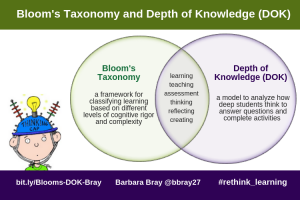 You can use Bloom’s Taxonomy as a guide for teaching and designing instruction and DOK as a guide for developing skills and encouraging deeper thinking and learning.
You can use Bloom’s Taxonomy as a guide for teaching and designing instruction and DOK as a guide for developing skills and encouraging deeper thinking and learning.
How do you see both either working together or separately to support your teaching practice and the different needs of your learners?
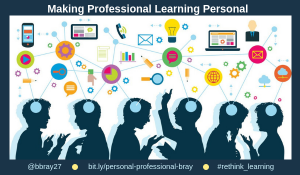 Teachers may find that they will be learning something new more often than not. Teachers are a valuable element in the classroom and mean so much to each student. They need to be valued and appreciated. The activities need to be personal for each teacher. That is where teachers can take control of their own learning.
Teachers may find that they will be learning something new more often than not. Teachers are a valuable element in the classroom and mean so much to each student. They need to be valued and appreciated. The activities need to be personal for each teacher. That is where teachers can take control of their own learning.
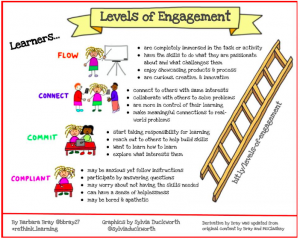 Engagement is about how much any learner is engaged in a task or activity and the balance between the challenge before them and the skills they have to meet that challenge. The levels are more about how the learner is engaged in learning, not about the teacher or the learning environment. This idea of levels of engagement can pertain to any of us who are defining who we are as a learner.
Engagement is about how much any learner is engaged in a task or activity and the balance between the challenge before them and the skills they have to meet that challenge. The levels are more about how the learner is engaged in learning, not about the teacher or the learning environment. This idea of levels of engagement can pertain to any of us who are defining who we are as a learner.
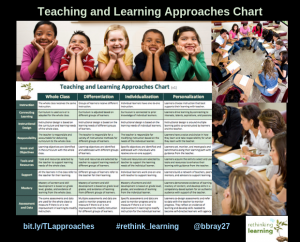 Moving to learner agency takes time for students and teachers. Students may not be ready to let go. Teachers may not have the support, resources, or time to jump in and change how they teach right away. When teachers and learners build positive relationships first and a culture where everyone’s voice is valued, they will know when to change and try new ideas. This chart is meant as a guide and to calm the fears about changing what they know and do around teaching and learning that I heard from teachers.
Moving to learner agency takes time for students and teachers. Students may not be ready to let go. Teachers may not have the support, resources, or time to jump in and change how they teach right away. When teachers and learners build positive relationships first and a culture where everyone’s voice is valued, they will know when to change and try new ideas. This chart is meant as a guide and to calm the fears about changing what they know and do around teaching and learning that I heard from teachers.
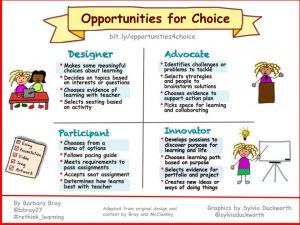 Many teachers believe that providing a set of choices from a computer program or a list of options was enough to give students opportunities for choice. I see so many teachers working way too hard to create opportunities for students to choose the best way to learn. The idea of developing opportunities for choice is to turn over the learning so students learn best by having them be the ones working harder than the teachers.
Many teachers believe that providing a set of choices from a computer program or a list of options was enough to give students opportunities for choice. I see so many teachers working way too hard to create opportunities for students to choose the best way to learn. The idea of developing opportunities for choice is to turn over the learning so students learn best by having them be the ones working harder than the teachers.
 Humans are naturally social beings. The better the relationships are at school, the happier and more productive students and teachers will be. When relationships are working, everyone is happier, more innovative and creative. Building positive relationships with students, teachers, and all school staff in school will spill over to the school community.
Humans are naturally social beings. The better the relationships are at school, the happier and more productive students and teachers will be. When relationships are working, everyone is happier, more innovative and creative. Building positive relationships with students, teachers, and all school staff in school will spill over to the school community.
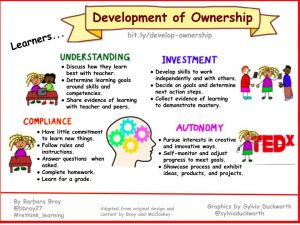 Developing ownership of learning takes time and that it doesn’t always happen in school. Most of us grew up in a system that valued sameness and compliance. Learners can move from compliance to autonomy by teachers creating an environment that provides learners with choices and opportunities for growth and ownership of learning. When a learner at any age pursues an interest that they are passionate about, they are motivated to learn and want to own their learning.
Developing ownership of learning takes time and that it doesn’t always happen in school. Most of us grew up in a system that valued sameness and compliance. Learners can move from compliance to autonomy by teachers creating an environment that provides learners with choices and opportunities for growth and ownership of learning. When a learner at any age pursues an interest that they are passionate about, they are motivated to learn and want to own their learning.
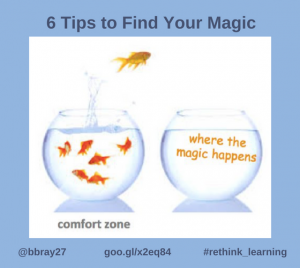 Being uncomfortable is kind of the new norm today. The world is changing so fast that no one knows what is ahead for us. There is uncertainty about the type of work is needed in the future. That impacts all of us. You will be amazed at how you will be able to live with uncertainty easier every day and build a growth mindset about whatever you want to do. “What are the worst things that could happen if I go out of my comfort zone? What are the best things that could happen?
Being uncomfortable is kind of the new norm today. The world is changing so fast that no one knows what is ahead for us. There is uncertainty about the type of work is needed in the future. That impacts all of us. You will be amazed at how you will be able to live with uncertainty easier every day and build a growth mindset about whatever you want to do. “What are the worst things that could happen if I go out of my comfort zone? What are the best things that could happen?
I hope you enjoy these posts. There are more posts I wrote and resources for you on Rethinking Learning. There is a complementary post for each podcast created by me and the person I interviewed. I guess I’ll have to create another post about why I started my podcast and decided to create separate posts with each one. I welcome any comments and encourage you to share any of the posts on social media.
*****
Interested in checking out more of the Rethinking Learning podcasts and reflections, click on the podcast tab at the top, the logo below, or go to https://barbarabray.net/podcasts/
For more information about Barbara’s new book, Define Your WHY, go to this page or click on the image of the book for resources, questions, and links.

